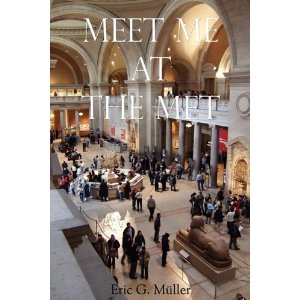Book Review
Meet Me at the Met
by Eric G. Müller
Judging a book by its cover is often a mistake. At first glance I would have mistaken this book for a guide to the Metropolitan Museum of Art in New York City, whereas it's really a guide to the joys and travails of a naïve (euphonism for schmuck) guy who uses the Met as cultural food for his soul when he is happy as well as when he is down and out. So yes, it's a novel, whose anti-hero is actually named Clarence – perfect name for a schmuck, but a lovable one. In another sense, though, it's also a fictional guide to the Met.
Clarence, facing a midlife existential crisis, needs a place to write in peace and he picks the Museum. Why? Because, like the proverbial mountain, it's there, along with an very artistic atmosphere, and cafés. So why not?
If this doesn't sound like a promising action movie script, well, so what? There is action and there is romance – Clarence has an American wife, who leaves him for another...er...woman, an Indian lover, who leaves him for India, and a Swiss mountain gal for a one-night stand, who just leaves. But we have no time to get into the intricacies of the plot, what there is of it, so I'd like to introduce you to Müller's writing, which is what mostly wins my accolades.
It's 9:30 a.m. and I'm one of the first to enter the Met, making my way to the seclusion of the Astor Court. In the fashion of the Ming scholars I retreat to this exquisitely recreated Garden Court, in search of quietude. I have always loved the harmony of this microcosmic natural world and the light and airy feel of the place. I sit cross legged on the patterned tiles surrounded by rocks, plants and water, especially positioned according to a formula replicated over eons. My ears receive the sweet sounds of water over perforated and wrinkled rocks, conjuring forth pictures of exotic birds and animals, or caves and mysterious grottos, inhabited by immortal beings. The interplay between the mobile water and the immovable rocks is a perfect manifestation of the yin and yang in all of its feminine and masculine qualities — the polarities of the world in their most complementary form. As I sit, sinking into this order of domesticated wilderness I feel the rejuvenating qualities of water with all of my senses - the shadowy, wet, cool, soft, gentle, and yielding yin, as opposed to the hard, solid, flashy, sturdy, dense, hot, dry, and unyielding yang. And slowly the balancing properties begin to have their harmonizing effects on me, resolving my own dissonances.
Partly restored, I get up and sit on the stone bench of the "viewing terrace," the area where the scholars would come to write poetry or sample new tea during the full moon. I take out my green notebook, not to write poetry, but to record the painful incident we'd hoped to avoid.
Clarence manages to do a lot of writing at the Met, in fact enough to fill this book. At each sitting he also introduces us to one or more of the Met's beauteous attractions, whether a Rembrandt painting or the Inner Chamber of the Temple of Dendur. But it's not all high culture. There's love, violence and even sex – although the latter takes place outside the Met (just in case you were hoping). Clarence finds himself on a remote Swiss mountain – neither he nor the author, who I suspect are one and the same, explain what on earth he's doing there. He encounters a teenage girl about to commit suicide by jumping off a bridge and he saves her. She only speaks the Swiss-German dialect, unintelligible even for Germans, so Clarence is reduced to sign language and misty glances. She leads him to her bedroom over a barn full of munching cows where, amidst an audience of Jesus and Mary icons, lit by votive candles, they make love. But then her drunken brute of a father, who had been abusing her for years, enters and, after taking off his trousers, is mightily surprised to find our Clarence occupying his reserved space. A battle worthy of the Karamazovs ensues, which Clarence wins, so he and the girl repair to his hotel where, it is implied, they continue their illicit activities sans paternal interruption. The next morning she has disappeared. Clarence has liberated her. But now comes the real proof that he is a unmitigated schmuck: he tells his wife! who is far from understanding.
Although this unlikely event reminds more of Mark Twain than Eric Müller, and could be considered out of context, it plays its inevitable role as a bridge, the novel's climax, as it were. So back to the Met.
The bulk of the Met's contents are a testimony of “man's” belief, search and struggle with the unseen world. In this respect the Met is a microcosm of the world's ever-evolving consciousness; the works of art as analogous to larger life and our special place in it. Modernity has basically denied spirituality, but it would appear we've not put anything that satisfies in its place – though we have, in fact, an insatiable craving for it, embodied in our constant struggle for freedom. In our scramble to understand freedom, and what it means for the individual and society, we'll discover the new spirituality needed for our age, of that I'm convinced.
Words which confirm Clarence's naïve optimism or schmuck-hood, take your pick.
Well, whatever we may think of Clarence – he's certainly not Spiderman, despite having won fights against the Swiss lover's muscular dad and the Indian lover's insanely jealous husband – he is the mouthpiece/narrator for a richly intriguing, original in its own way, poetic novel. Try it and you won't be disappointed - guaranteed.
Frank Thomas Smith
"Meet Me at the Met" from Amazon
Home

